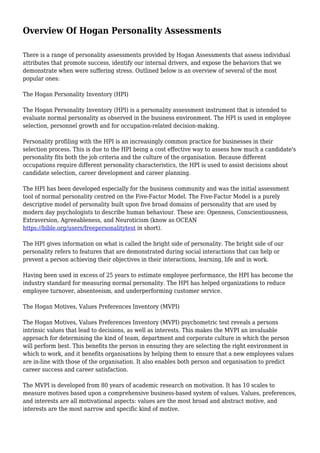
Overview Of Hogan Personality Assessments
- 1. Overview Of Hogan Personality Assessments There is a range of personality assessments provided by Hogan Assessments that assess individual attributes that promote success, identify our internal drivers, and expose the behaviors that we demonstrate when were suffering stress. Outlined below is an overview of several of the most popular ones: The Hogan Personality Inventory (HPI) The Hogan Personality Inventory (HPI) is a personality assessment instrument that is intended to evaluate normal personality as observed in the business environment. The HPI is used in employee selection, personnel growth and for occupation-related decision-making. Personality profiling with the HPI is an increasingly common practice for businesses in their selection process. This is due to the HPI being a cost effective way to assess how much a candidate's personality fits both the job criteria and the culture of the organisation. Because different occupations require different personality characteristics, the HPI is used to assist decisions about candidate selection, career development and career planning. The HPI has been developed especially for the business community and was the initial assessment tool of normal personality centred on the Five-Factor Model. The Five-Factor Model is a purely descriptive model of personality built upon five broad domains of personality that are used by modern day psychologists to describe human behaviour. These are: Openness, Conscientiousness, Extraversion, Agreeableness, and Neuroticism (know as OCEAN https://bible.org/users/freepersonalitytest in short). The HPI gives information on what is called the bright side of personality. The bright side of our personality refers to features that are demonstrated during social interactions that can help or prevent a person achieving their objectives in their interactions, learning, life and in work. Having been used in excess of 25 years to estimate employee performance, the HPI has become the industry standard for measuring normal personality. The HPI has helped organizations to reduce employee turnover, absenteeism, and underperforming customer service. The Hogan Motives, Values Preferences Inventory (MVPI) The Hogan Motives, Values Preferences Inventory (MVPI) psychometric test reveals a persons intrinsic values that lead to decisions, as well as interests. This makes the MVPI an invaluable approach for determining the kind of team, department and corporate culture in which the person will perform best. This benefits the person in ensuring they are selecting the right environment in which to work, and it benefits organisations by helping them to ensure that a new employees values are in-line with those of the organisation. It also enables both person and organisation to predict career success and career satisfaction. The MVPI is developed from 80 years of academic research on motivation. It has 10 scales to measure motives based upon a comprehensive business-based system of values. Values, preferences, and interests are all motivational aspects: values are the most broad and abstract motive, and interests are the most narrow and specific kind of motive.
- 2. Measures of motives, values, and interests through the MVPI are different from personality measures. Personality measures (such as MBTI, HPI or HDS psychometric assessments) provide insight as to how an employee may behave given a certain situation. Motives, values and interests inventories instead provide an insight in to what a person feels the need to do. Motives, values, and preferences are perceived to be largely stable; they tend to change very little as a person grows older - what attracts you now will have the same effect you later. The Hogan Development Survey (HDS) The Hogan Development Survey (HDS) is a unique business-related personality assessment that seeks to measure a persons impaired behavioural patterns. HDS evaluates eleven personality-based performance risks that have the ability to hinder work relationships and impede productivity. These performance hazards also have the capability to restrain the general career potential of the person. These career derailers, as they are named, are in effect instilled personality traits which affect upon the persons behaviour and actions. Because of this it is a useful evaluation amongst senior executives whose actions are vital to the business. It also provides in-depth information about interpersonal problems that are not always easily identifiable in interviews. The HDS can help an employee recognise the important factors that discern personalities and determine occupational achievement. Many people refer to the Hogan Development Survey as identifying the Dark Side of a persons behaviour. By this they mean the survey showing what we see when a person is in a situation where they are under pressure. When under stress or pressure, a person can display counterproductive tendencies. In normal circumstances these tendencies or characteristics may actually be seen as strengths. However, when a person comes under stress or pressure, which may include feeling irate, bored or distracted, these performance risk factors may hinder a persons abilities, resulting to a decline in relationships with customers, colleagues and managers. Virtually all employees will at some point exhibit extreme behaviours, usually due to these circumstances. It is the odd occasions where we show our dysfunctional behaviour that can have a high negative impact on our career. The Hogan Development Survey assessment therefore provides valuable information that will enhance an individuals self-awareness. This can lead them to be better placed to avoid the detrimental consequences that are connected with these tendencies and characteristics. By discovering these behaviour patterns it is therefore possible for the individual to compensate for them through personal improvement.